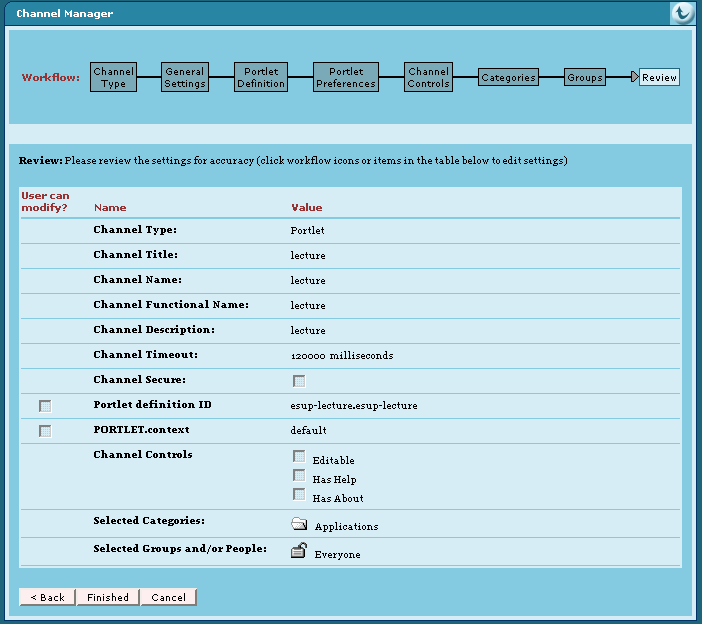...
- Configure a new context in your application server. For example with Tomcat create a LecturePortlet.xml file in the Toncat conf/Catalina/localhost subfolder with content like this:
ATTENTION : Cf FAQ : http://www.esup-portail.org/display/PROJESUPLECTURE/FAQ+(French)?showComments=true#commentsBloc de code <Context path="/esup-lecture" docBase="D:/esupdev/esupdev-2.5-esup-2/uPortal-quick-start/webapps/esup-lecture" />
Configuring the portlet in
...
the portal
- Configure your portal to reference this portlet. For example with uPortal you can use channel manager as shown here:
Remarque Portlet definition ID is very important. Here it is esup-lecture.esup-lecture. Fisrt esup-lecture must be equal to the appliation server context name and second esup-lecture must be equal to the portlet-name of the WEB-INF/portlet.xml file.
If you don't use this default value you have to adap the "portlet-guid" parameter of "The esup-lecture portlet servlet" servlet in the WEB-INF/web.xml too.
If you don't use channel manager you can use a xml Portlet definition file. You can use this file with an uPortal ant target like ant uportal.pubchan -Dchannel=lecture-portlet.xml. For this, you have to save a lecture-portlet.xml file in the folder properties/chanpub of your uPortal distribution. This is an example of lecture-portlet.xml file :Remarque You can specify a preference with name "context" here too. See chapter 2.2.1 about context id for more information about this.
Bloc de code <?xml version="1.0" encoding="UTF-8"?> <!DOCTYPE channel-definition SYSTEM "channelDefinition.dtd"> <channel-definition> <title>lecture-portlet</title> <name>lecture-portlet</name> <fname>lecture</fname> <desc>Esup-Portail lecture portlet</desc> <type>Portlet</type> <class>org.jasig.portal.channels.portlet.CPortletAdapter</class> <timeout>15000</timeout> <hasedit>N</hasedit> <hashelp>N</hashelp> <hasabout>N</hasabout> <secure>N</secure> <locale>en_US</locale> <categories> <category>Applications</category> </categories> <groups> <group>Everyone</group> </groups> <parameters> <!-- The syntax of the portletDefinitionId is [portlet-context-name].[portlet-name] --> <parameter> <name>portletDefinitionId</name> <value>esup-lecture.esup-lecture</value> <description>The syntax of the portletDefinitionId is [portlet-context-name].[portlet-name]</description> <ovrd>N</ovrd> </parameter> <parameter> <name>PORTLET.context</name> <value>default</value> <description>The "context" Portlet preference in relationship with context@id of the esup-lecture.xml file</description> <ovrd>N</ovrd> </parameter> </parameters> </channel-definition>
...
Adding esup-lecture styles in
...
the portal
- Import lecture.css and thickbox.css (if you are using thickbox for news focusing) in main portal css page :
For example with esup skin in a esup-portail package:- copy esup.css from update/uPortal/webpages/media/org/jasig/portal/layout/tab-column/xhtml-theme/esup to custom/uPortal/webpages/media/org/jasig/portal/layout/tab-column/xhtml-theme/esup/skin
- adapt esup.css by adding :
Bloc de code @import url("lecture.css"); @import url("thickbox.css"); - copy lecture.css and thickbox.css in custom/uPortal/webpages/media/org/jasig/portal/layout/tab-column/xhtml-theme/esup/skin
- use ant init deploy
...
